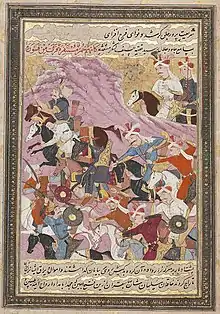Musha'sha'
The Musha'sha' (also spelled Mosha'sha'; Arabic: المشعشعية) were a Shi'i Arab dynasty based in the town of Hoveyzeh in Khuzestan,[1] ruling from 1435 to 1924.[2] Initially starting out as a tribal confederation, they gradually transformed into a zealous Isma'ili-Shi'i dynasty.[3] The independence of the Musha'sha' was put to an end in 1508 by the Safavid shah (king) Ismail I (r. 1501–1524), who claimed to be the only legitimate Shi'i ruler.[1] Following this, the Musha'sha remained compliant, typically serving as valis or governors under Iranian suzerainty for the following centuries.[4]

The Musha'sha' were founded and led by Muhammad ibn Falah, an Iraqi-born theologian who believed himself to be the earthly representative of Ali and the Mahdi. From the middle of the 15th century to the 19th century, they came to dominate much of western Khuzestan in southwestern Iran.
Beginning in 1436, Ibn Falah spread his messianic beliefs amongst the less powerful Arab tribes along the area of the present-day border of Iraq and Iran, gaining converts in an attempt to forge a strong tribal alliance.[5] In 1441, they succeeded in capturing the city of Hoveyzeh in Khuzestan, and during the following ten years the Musha‘sha’iyyah increased their strength and consolidated their power in the area around the city and the Tigris. These early military ambitions were fueled by Muhammad ibn Falah's zealous millenarian theology, which continued to significantly influence the later military campaigns of the Musha‘sha’iyyah decades after his death.
Successors of Ibn Falah were in continual conflict with the Safavid rulers as well as with Iranian Arab tribes until overcome by the Safavids in 1508.[6] The conflict with the Safavids was driven not only by politics and territorial domination, but also by theological differences and competition between two rival Shi'a schools of thought. According to Moojan Momen, both sects adhered to heterodox (ghuluww) Shi'i beliefs.[6]
According to the order's Islamic eschatology, the Mahdi will appear at the end times in Yemen to lead the forces of good in a struggle against the forces of evil, who will be based in Syria and Greater Khorasan. The Musha‘sha’iyyah believed that the end times were imminent and that they would need to defeat the Safavids and gain control of Iran in order to fulfill the prophecy heralded by ibn Falah.
The Musha‘sha’iyyah gradually abandoned their heretical beliefs and were absorbed to mainstream Twelver Shī‘ah orthodoxy. Like other mystical Shī‘ah sects, they placed a great deal of importance upon poetry and art.
Unreferenced sources indicate that their rule ended towards the 19th century with the rise to power of the Banu Ka'b, which, under the leadership of Jabir al-Kaabi, had become the dominant power in the western region of Iran. However, Momen writes that by the 16th century they were already reduced to being the governors of Khuzestan.[6]
See also
References
- Luft 1993, p. 673.
- Bosworth 1996, p. 277.
- Matthee 2015, p. 450.
- Bosworth 1996, p. 279.
- Britannica
- Momen, Moojan (1985), An introduction to Shiʻi Islam : the history and doctrines of Twelver Shiʻism, New Haven: Yale University Press, p. 102, ISBN 0-300-03531-4
Further reading
- Akopyan, A. V.; Mosanef, F. (2015). "THE COINAGE OF THE MUSHAʿSHAʿ" (PDF). Journal of the Oriental Numismatic Society. 223: 13–20.
- Bosworth, C.E. (1996). The New Islamic Dynasties: A Chronological and Genealogical Manual. New York City: Columbia University Press. ISBN 0-231-10714-5.
- Floor, Willem (2008). Titles and Emoluments in Safavid Iran: A Third Manual of Safavid Administration, by Mirza Naqi Nasiri. Washington, D.C.: Mage Publishers. ISBN 978-1933823232.
- Luft, P. (1993). "Mus̲h̲aʿs̲h̲aʿ". In Bosworth, C. E.; van Donzel, E.; Heinrichs, W. P. & Pellat, Ch. (eds.). Encyclopaedia of Islam. Volume VII: Mif–Naz (2nd ed.). Leiden: E. J. Brill. ISBN 978-90-04-09419-2.
- Matthee, Rudi (2011). Persia in Crisis: Safavid Decline and the Fall of Isfahan. I.B.Tauris. ISBN 978-0857731814.
- Matthee, Rudi (2015). "Relations between the Center and the Periphery in Safavid Iran: The Western Borderlands v. the Eastern Frontier Zone". The Historian. 77 (3): 431–463. doi:10.1111/hisn.12068. S2CID 143393018.
- Sanikidze, George (2021). "The Evolution of the Safavid Policy towards Eastern Georgia". In Melville, Charles (ed.). Safavid Persia in the Age of Empires: The Idea of Iran. Vol. 10. I.B. Tauris. pp. 375–404.
- Borgomale, H. L. Rabino di (1950). "Coins of the Jalā'ir, Ḳara Ḳoyunlu, Musha'sha', and Āḳ Ḳoyūnlū dynasties". The Numismatic Chronicle and Journal of the Royal Numismatic Society. Sixth Series. 10 (37/38): 94–139.